How To Remove Training Wheels
Grooming wheels were designed to simplify the procedure of learning to ride a bicycle, but they often lead to more defoliation! Although balance bikes are becoming much more mainstream twelvemonth by year, bike training wheels are still the standard "become-to" for many families.
Equally a consequence, we often become a lot of questions about them, especially in regards to how to use them and how to get rid of them! If we missed your question or if you have boosted questions, please go out your question in the annotate section below!
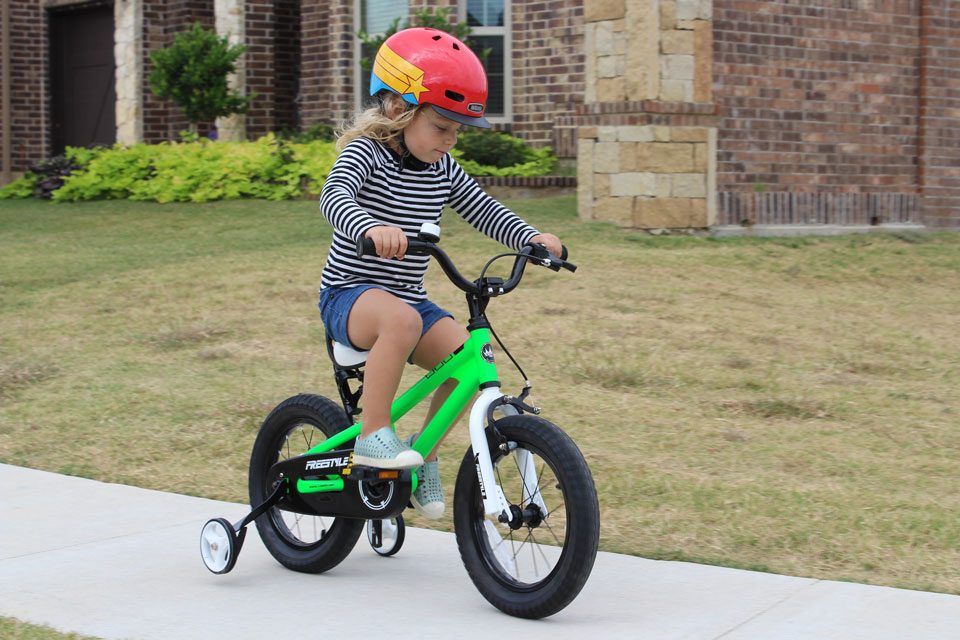
1. Do preparation wheels piece of work?
Training wheels help kids stay upright on a bike and pedal at an earlier age. If your goal is for your child to pedal a bike while assisted, and so yeah, they work.
Merely if your goal is for your kid to learn to ride a bike, the answer is no, they exercise non work because they don't actually train kids to ride a bike. As soon as they come off, the existent preparation begins! From running beside them while holding onto the seat, to the numerous pep-talks after crashes, transitioning a child off of them isn't easy.
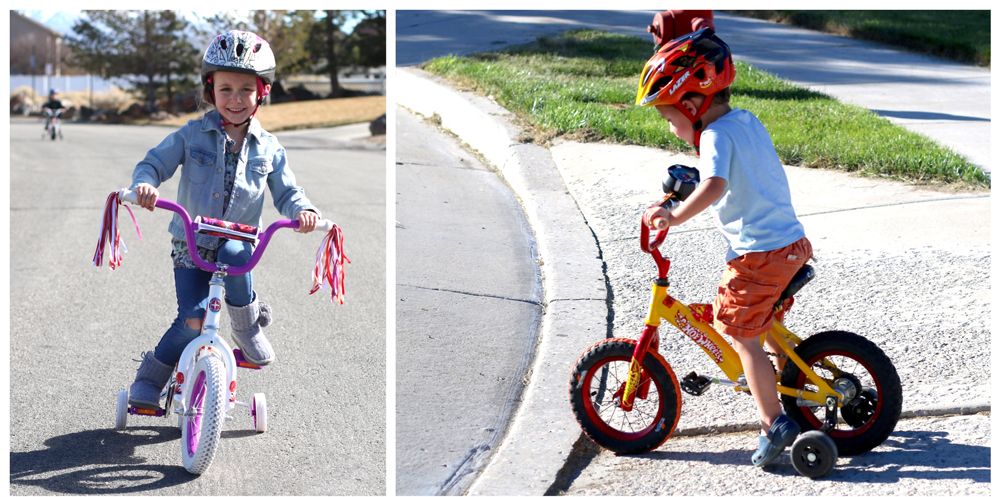
Why? Considering training wheels don't teach a child how to balance a bike, which is the first and most difficult requirement for learning how to ride a bike. People often assume learning how to pedal is the first requirement – it's not. One can easily "ride" a bike past sitting on the seat and running with your legs, no pedals required.
The emphasis on training kids to balance over grooming them to pedal is why balance bikes have become increasingly popular. For more than information, check out our detailed explanation of the differences between riding with grooming wheels and a residue bike.
2. Are rest bikes improve than preparation wheels?
Yes! Balance bikes teach kids to rest and let them to independently ride a cycle as young every bit 18 months old. Fast and nimble, residual bikes can take kids of all ages up and over jumps, curbs, and hills, as well as over various terrains.
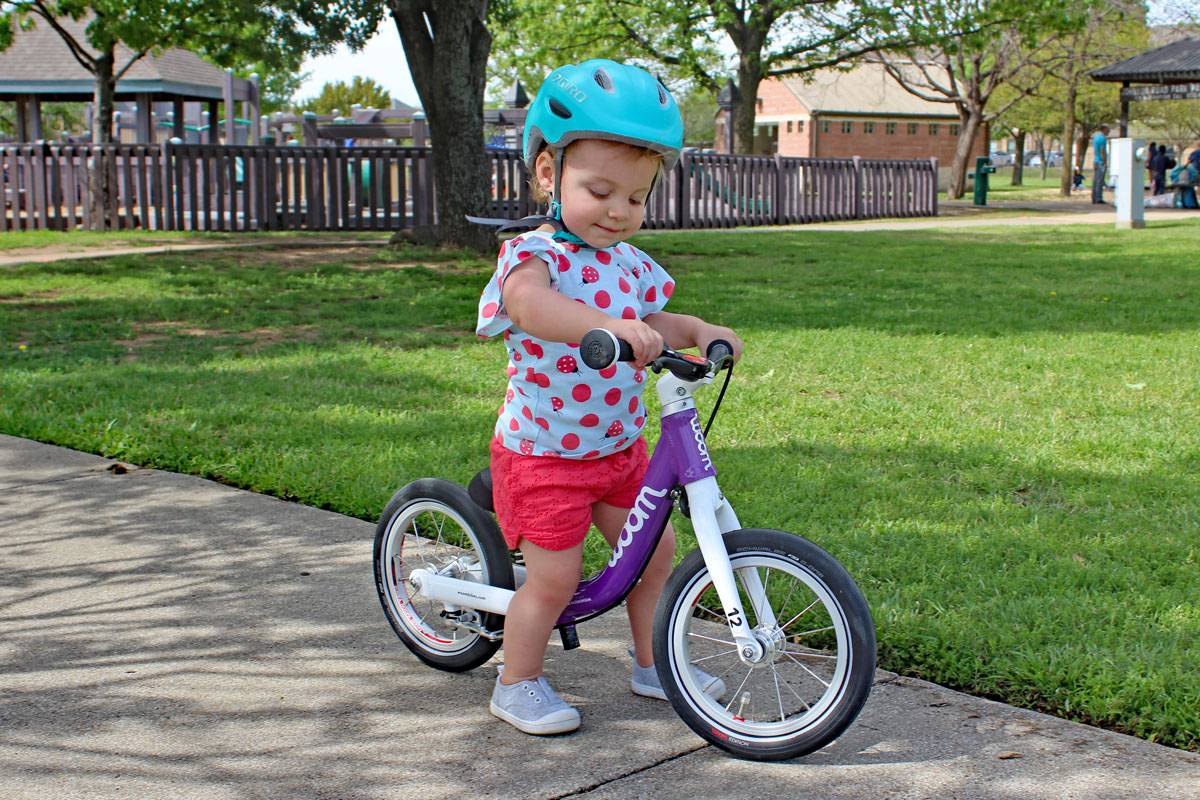
Bikes with training wheels, however, require kids to be older and taller to start riding (typically effectually 3 or four years old) and they are also limited to riding on flat surfaces. Kids who graduate from a residue bicycle also do non ever need training wheels to master a pedal bicycle – they typically just get on the bicycle and grasp riding within a couple of minutes.
If you'd like to see our favorite balance bikes for any budget, check out our 10 All-time Balance Bikes listing. Need more than convincing? Cheque out our article Residuum Bikes vs. Grooming Wheels.
3. At what age exercise kids employ them?
Kids typically brainstorm riding a bike with grooming wheels around three to 5 years old, only the historic period range spans from 3 to eight. They are available on bikes of various sizes to accommodate kids of various ages.
While many 3-twelvemonth-olds are ready for a bike with them, finding a bike small enough to fit them comfortably can be challenging. In society for a child to properly "fit" on a bike with grooming wheels, they should ideally be able to bear on the ground with both of their feet at the same time while seated on the wheel.
three-Year-Old on Residual Bike vs. 12″ Cycle with Training Wheels
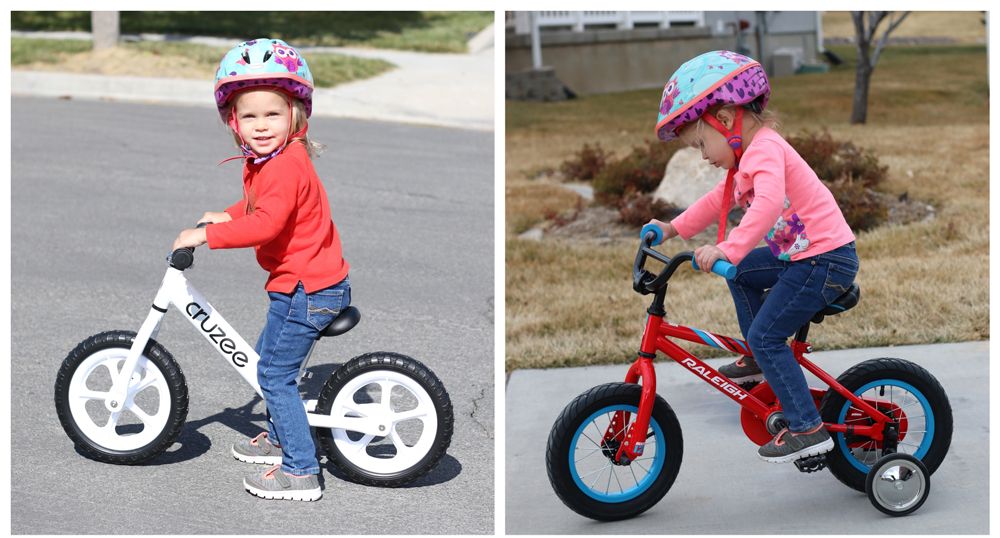
iv. Can you put them on whatsoever bicycle?
Bike training wheels are mounted on the rear axle of a bicycle and do not work with every bicycle. While most kids' bikes plant at big-box stores come up with or tin can arrange them, many college-ends kids' bikes cannot.
In order to adapt training wheels, the bike's rear axle needs to be long enough to support the arm of the preparation bicycle as well as an additional bolt and washer to hold them in place. These ii bolts are located on the outside of the bike frame. Bolts located between the rear tire and the inside of the frame play no role in supporting training wheels.
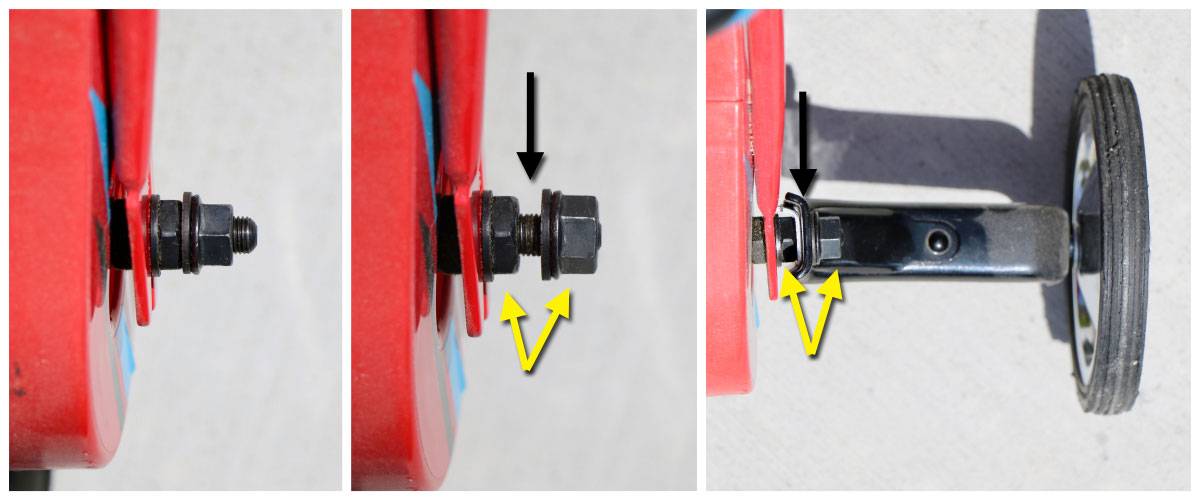
If the rear beam on a bike is too short to agree an additional bolt, the bicycle is not uniform. Almost higher-terminate bikes, such as woom and Guardian, are not compatible as most of their riders are moving up from a balance cycle, so they aren't necessary.

5. Can you put them on a 24-inch cycle?
While there are training wheels that will fit 24″ bikes, most 24″ bikes exercise not take a rear axle long enough to fit them. As a result, specialized training wheels that mount onto the frame of the bike (rather than the beam), like these CyclingDeals training wheels, are usually required.
If your 24″ bike is geared and has a rear derailleur, you must take preparation wheels that adhere to the frame, rather than the axle.
Frame-Mounted vs. Axle-Mounted Wheels

half-dozen. Are wheel grooming wheels supposed to touch the ground?
Preparation wheels should always be set slightly college than the rear tire. While this does cause the child to tilt dorsum and forth on the bicycle as they ride, this uneven riding is oddly necessary for safety reasons.
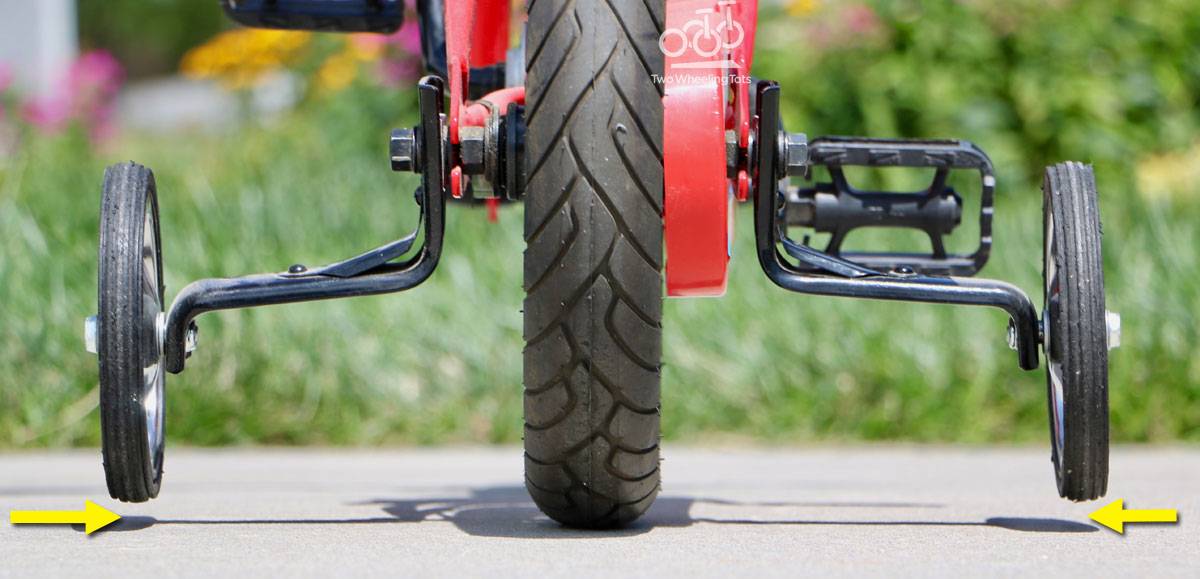
If all three wheels were touching the ground (2 grooming wheels + bike's rear tire), it would be impossible to consistently keep virtually of the weight on the bike'due south rear tire. If the weight of the bike is on the preparation wheels rather than the rear tire, the rear tire will not be able to maintain proper traction and braking ability volition be limited.
The vast majority of kids' bikes with grooming wheels take a rear coaster brake (back pedal brake) that stops the bike, and so it is essential that the rear tire ever exist in contact with the ground and with as much weight on the back tire as possible.
In theory, as a child becomes a more confident passenger on the bike, the grooming wheels should exist moved up college to encourage kids to balance the wheel without them. Unfortunately, without continual guidance and encouragement tonot lean to one side while riding, raising them rarely helps kids learn to balance the bike on their own.
What usually happens is that as they are raised, a child but leans more drastically to the side and gets freaked out! Raising them rarely encourages a child to stay more upright and balanced. Equally a result, nigh kids practice not learn to balance a bicycle until after they take been completely removed.
7. Are they supposed to exist uneven?
Bicycle training wheels are ready at an equal height above the rear bike. While they are fifty-fifty with 1 another, the rider feels uneven because they are constantly tilting to ane side.
Because both preparation wheels can never touch the ground at the same time, a child must ride at a tilt for one of the wheels to brand contact with the ground and maintain stability. This unnatural tilt is designed to encourage kids to stay upright, which in theory would help them learn to balance a cycle on 2 wheels. Unfortunately, we've never seen it work this mode.

8. What are the best bikes with grooming wheels?
If you plan on purchasing a bike with training wheels, the Specialized Riprock 12″ and 16″ are our top picks. Specialized's training bike design isvery stable compared to nearly brands and tin can be removed without any tools!
Decathlon's Btwin Bikes, bachelor in 12″ and 16″ bikes, also offer quality preparation wheels at a very family-friendly price tag.

There are a few high-cease bikes that are compatible, although they don't come with them. Pello Bikes and Priority Bicycles are ii exceptional brands that we highly recommend.

9. What are the best ones if I already take a bike??
If your 12″, 14″ or 16″ bike did not come with them, it's very likely that the bike is not compatible. Prior to purchasing any, be sure to check with the bike manufacturer to ensure the bicycle is compatible. Often times, the rear axle on higher-stop brands is as well brusk to mountain training wheels.
If your cycle is compatible "heavy duty" training wheels that have an boosted stabilization bar betwixt the mounting arm and axle arm are your best bet. Several brands are readily available, such every bit the Fortop or Little World.
Heavy Duty vs. Standard

For those who need training wheels for a twenty″ bicycle or larger, it'southward very likely that the cycle will not accommodate traditional training wheels that attach to the rear beam. Special training wheels that adhere the frame of the wheel, such equally the CyclingDeals Adult, are likely needed.
10. How practice I get my kid off training wheels?
In that location are several different methods to aid your child move on from them. Our favorite method is to remove the training wheels likewise as the pedals of the bicycle and essentially use the bike as a balance bicycle.
Using this method, you lower the seat of the wheel so that the child can stand over the cycle with their feet flat and have them practice running and gliding on the bike.

Removing the pedals of the bike is not essential, but it prevents kids' legs from hitting the pedals during their pace. If your kid is hesitant to showtime running on the bike, practicing on a grassy hill is a great way to aid them speedily get the feel for gliding.
Once your child tin can successfully run and glide on the bike, information technology's time to put the pedals back on! With the pedal backs on, have the child once once more run and glide on the wheel andthen showtime pedaling. Information technology'southward much easier for kids to rest and pedal a bike once it's moving, and then do not take the kid endeavor to kickoff pedaling a bike from a standstill (that will come with fourth dimension).
How To Remove Training Wheels,
Source: https://www.twowheelingtots.com/training-wheels-faq/
Posted by: burkhardtinizing.blogspot.com


0 Response to "How To Remove Training Wheels"
Post a Comment